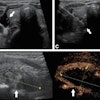
The COVID-19 pandemic resulted in a 50% decline in exam volume at hospitals using general ultrasound equipment, according to a new report from IMV Medical Information Division. But hospitals are seeing volume rebound as they plan a return to normal operations.
 Lorna Young of IMV Medical Information Division.
Lorna Young of IMV Medical Information Division.The report found that an estimated 38.5 million patient exams were performed in 2019 using general ultrasound equipment that radiology/imaging departments in U.S. hospitals own or manage for their hospitals and associated outpatient locations.
Of these, 81% of the patient exams were performed in the main radiology department and 19% were performed in other departments and locations where radiology owns or manages general ultrasound equipment, such as emergency departments, patient floors, interventional radiology labs, surgery/operating rooms/hybrid operating rooms, anesthesiology, and ob-gyn/maternity/labor and delivery departments.
IMV's newly published 2020 General Ultrasound Market Outlook Report focuses on how radiology/imaging departments in U.S. hospitals are using the general ultrasound equipment that they own or manage for their hospitals and associated outpatient locations, including conventional cart-based, laptop/tablet, and handheld units.
Due to COVID-19, this report also assesses the impact the pandemic is having on general ultrasound operations, as well the actions being taken by the radiology/imaging departments to deal with the crisis.
The gold standard
A 96% majority of these 38.5 million patient exams were performed using conventional cart-based ultrasound scanners, as this configuration type continues to be the gold standard for general ultrasound in a broad array of clinical applications. With technology innovations pushing the frontiers of image quality and portability, the availability of laptop/tablet and handheld units have expanded the use of ultrasound in point-of-care and other locations inside and outside the hospital. While virtually all hospitals covered in the survey had conventional cart-based general ultrasound units, over one-quarter (28%) of the radiology departments own or manage laptop/tablet or handheld general ultrasound units for their hospitals.
The COVID-19 pandemic is having widespread impact across the U.S., and it has had an immediate impact on general ultrasound patient exam volume. IMV's survey was conducted in April/May 2020, and the respondents were asked how many patient exams were conducted in January, April, and May 2020.
Based on their responses, while the estimated monthly ultrasound patient exam volume in January 2020 was nearly 3.3 million scans nationwide, the monthly total declined by 49% in April 2020. Patient exams started to rise in May, up 28% from April, but was still 34% below January levels.
The top change affecting general ultrasound due to COVID-19 is "declines in ultrasound patient exam volume due to reduction in related elective procedures," with 90% of the respondents so indicating. The exact timing and nature of a full recovery for ultrasound operations to return to "normal" is still uncertain, but 39% of the respondents anticipated that they would regain their January volumes in one to two months, while 37% were less optimistic, feeling it would take three to four months, and 24% felt it would take five or more months.
The respondents were asked what actions their departments have already completed, have begun, or are considering in order to deal with the ongoing COVID-19 crisis and to prepare for the future. The top actions taken to date by about 80% of the departments have been to strengthen their disinfection routines for ultrasound patient rooms, the equipment, and probes.
Almost three-quarters of the hospitals have modified their scheduling and waiting room protocols and another one-fifth have begun the process. A major impact of disinfection routines on their workflow that respondents commented on is the need to increase the time scheduled between patients, which has reduced their operational efficiency and revenue.
- "We have decreased the number of slots a day to allow time for social distancing, which is impacting revenue."
- "Length of time it takes to do exams for COVID+ patients due to the don/doff of [personal protective equipment (PPE)] and extensive cleaning of the equipment."
- "Increased time to complete exams by 10-15 minutes per exam. Decontamination of ultrasound equipment after each use takes even longer."
- "Increased time between scheduled outpatients of 45 minutes to one hour."
As a result of the pandemic, general ultrasound operations across the country have experienced reduced operating hours or days open, hiring freezes of ultrasound staff, and staff layoffs/furloughs. As of this survey, just over one-third (35%) of the respondents said they had already resumed normal "pre-COVID" operating hours and days, but less than one fifth (17%) of the hospitals had reinstated their laid-off/furloughed ultrasound staff.
Staff morale is a key concern for the department administrators, with respondents citing reduced morale due to furloughs/layoffs and reduced hours, staff fears of contracting COVID-19, technologists taking medical/mental leaves to avoid working with COVID patients, and the associated stress with the day-to-day uncertainties. Over 80% of the respondents indicated that even if "post-COVID recovery" has taken place, "improving ultrasound staff satisfaction and morale" will be a top department priority.
Regarding their future plans for acquiring general ultrasound equipment over the next three years, the respondents were asked what their plans were as of January 2020, and what impact the pandemic may be having on those plans. As of January, 35% of the hospitals were "Yes, planning" to order at least one general ultrasound equipment type from 2020-2023, and an additional 18% were "Maybe planning," resulting in over half (53%) of the nation's hospitals "Yes" or "Maybe" planning to buy conventional cart-based, laptop/tablet, or handheld units.
However, about one-third of the respondents indicated that the pandemic has caused a decline in funding to purchase new ultrasound equipment or their operating budgets for accessories, probes, and consumables for use with ultrasound equipment. For all three general ultrasound equipment types, the key impacts will be delays in unit orders for 2020-2023 compared with their original plans, including replacement delays and a reduction in the number of units to be ordered.
While COVID-19 may be slowing the purchase of ultrasound equipment, the ultrasound decision-makers still prefer onsite demos to virtual alternatives. Onsite demos and presentations by sales reps are the top information source the respondents have used when purchasing general ultrasound equipment, with 90% so using.
In light of the pandemic, the respondents were asked about their preference for in-person contact versus virtual online alternatives, and onsite demos are still preferred by a 60% majority of the respondents.
- "In order to identify the best equipment based on our needs, in-person visits are necessary for hands-on approach and honest discussions regarding ease of use, workflow, and usability. Virtual alternatives can provide adequate alternatives for education and general overviews."
- "We need to see the unit in operation. We need to test the functionality. Already there is a disconnect with applications training moving more and more to online review."
- "If the salesperson providing the demo is approved through vendor software that the person is safe, and if the person has a COVID-19 test done two days prior to visiting and then self-quarantines, and wears PPE during the demo, then all should be well."
Lorna Young is senior director, imaging insights, at IMV Medical Information Division, part of Science and Medicine Group.
IMV's 2020 General Ultrasound Market Outlook Report provides insight into how radiology/imaging/ultrasound departments in U.S. hospitals are using the general ultrasound equipment that they own or manage for their hospitals and associated outpatient locations, including conventional cart-based, laptop/tablet, and handheld units. The report is based on responses from 202 radiology/imaging/ultrasound administrators and chief/lead sonographers in U.S. hospitals who participated in IMV's nationwide survey in May-June 2020. Learn how departments using general ultrasound equipment in U.S. hospitals are dealing with the impact of COVID-19 on their patient exams and buying plans, and what factors will influence their current priorities and future outlook. IMV's 2020 General Ultrasound Market Outlook Report explores trends in patient exam volume and types, installed base mix by the equipment types of conventional cart-based, laptop/tablet, and handheld units, purchase plans, preferred information sources for evaluating future purchases, and site operations characteristics. Survey results are projected to the universe of U.S. hospitals using general ultrasound equipment.
Ultrasound manufacturers covered in this report include Butterfly Network, Canon (Toshiba), Clarius, Fujifilm (Sonosite), GE, Hitachi, Konica Minolta, Mindray, Philips, Samsung, Shimadzu, Siemens (Acuson), and SonoScape.
The scope of this report covers general ultrasound equipment owned/managed by radiology/imaging/ultrasound departments in U.S. hospitals, as these were the departments targeted for this study. The report therefore does not cover ultrasound equipment NOT owned/managed by radiology/imaging/ultrasound departments, such as those owned/managed by other departments (e.g., cardiology, echocardiography labs, surgery/operating rooms, or OB-GYN/maternity/labor & delivery), nor does it cover independent nonhospital sites such as physician practices and independent imaging centers.
For information about purchasing IMV's report, visit the corporate website at http://www.imvinfo.com or call 703-778-3080 ext. 1033 to speak with a representative.
Disclosure: IMV Medical Information Division is a sister company of AuntMinnie.com.



















